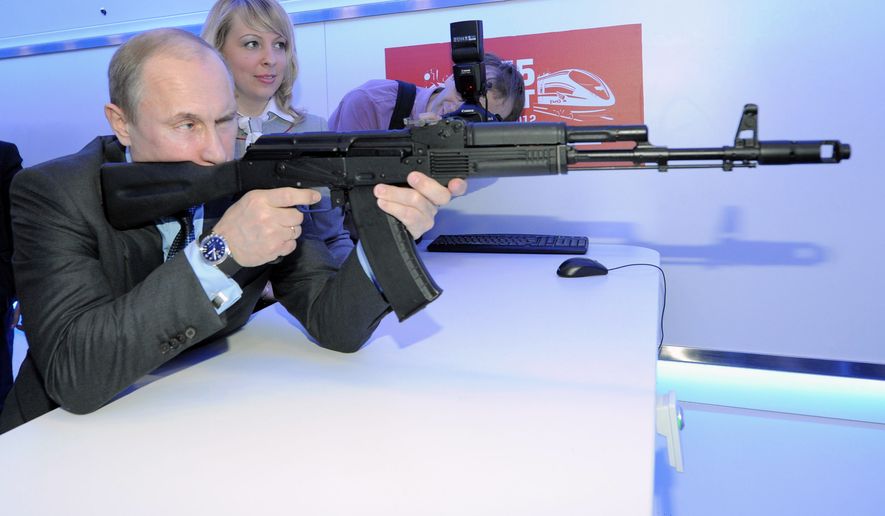Russia said Wednesday that it will deploy three newly created military divisions to protect its southern and western borders, days after U.S. and NATO military leaders unveiled plans to stand up a 4,200-member force in Eastern Europe to counter Russian aggression there.
The moves put fresh military assets behind a rising war of words between Russia and the West, amid steadily rising tensions along Russia’s western border with U.S. allies including Georgia, Ukraine and the Baltic States.
Those tensions were dramatized late last month when Russian fighter jets repeatedly buzzed a U.S. destroyer patrolling in the Baltic. An angry Pentagon denounced the flyby.
The new Russian divisions, totaling roughly 30,000 troops, will be in place by the end of this year, Russian Defense Minister Sergei Shoigu said in an interview with Russian media outlets. Mr. Shoigu said the move was a direct response to NATO’s plans to deploy thousands of troops into the Baltic region and rotate troops and materiel through the region on a regular basis.
“The Ministry of Defense has adopted [this] series of measures to counter the growing capacity of NATO forces in close proximity to the Russian borders,” Mr. Shoigu told the Tass news service.
The bulk of those forces will be deployed to Russia’s Western Military District, which sits along the borders with Ukraine, Belarus, the Baltic states and Finland, Mr. Shoigu said.
A day before his announcement, Defense Secretary Ashton Carter said NATO was weighing the establishment of a rotational ground force in the Baltic states and possibly Poland as a deterrent to Russian aggression, offering a blunt rebuke to what he said were provocations.
“We don’t seek a cold, let alone a hot war with Russia. We don’t seek to make Russia an enemy,” Mr. Carter said during a ceremony marking the installation of U.S. Army Gen. Curtis Scaparrotti as NATO’s supreme allied commander. “But make no mistake, we will defend our allies, the rule-based international order and the positive future it affords us.”
Saying he has had only limited contacts with Russia since he was named to the post, Gen. Scaparrotti told reporters in Belgium Wednesday that NATO should consider upgrading the weaponry it could provide to Ukraine to better combat a pro-Moscow insurgency. The Obama administration previously was wary of discussing such a move.
“I need to assess what weapons are best, what capabilities they can use, what capabilities are complementary to their forces today,” the new NATO commander said. “And I’ll make the more refined decision here as I get into this job.”
One of the military alliance’s biggest challenges, he said, is dealing with “a resurgent Russia striving to project itself as a world power.”
NATO Secretary-General Jens Stoltenberg argued Wednesday that any increased NATO deployment to the region was merely a defensive response to Russian actions.
“We didn’t have any troops in Baltic countries … before the illegal annexation of Crimea and Russia’s destabilizing activities in eastern Ukraine,” Mr. Stoltenberg said. “What we do is defensive, it’s proportionate and it’s fully in line with our international obligations.”
Enhanced force
The proposed expanded NATO force would consist of four battalions, or 4,000 troops, and would be in addition to the 4,200-member U.S. Army armored brigade that Pentagon officials plan to deploy separately to the region in February, Mr. Carter said in Stuttgart.
The Pentagon chief also held a private meeting with Danish Defense Minister Peter Christensen on Wednesday to discuss the proposed deployment of Danish F-16 fighters to the Baltics, according to a Pentagon readout of the meeting.
Gen. Scaparrotti said the additional troops would allow U.S. and NATO to be “ready to fight should deterrence fail” and added that Moscow continues to exhibit “aggressive behavior that challenges international norms.”
Pentagon spokeswoman Laura Seal said she could not comment on whether the proposed Russian creation of the military divisions would affect current or future U.S.-led operations in the region.
Although the U.S. and Russia have reached at least a working arrangement in the push for a cease-fire in Syria, the talk across the NATO-Russian border has grown increasingly hostile in recent days.
Secretary of State John F. Kerry said the USS Donald Cook would have been justified in firing on the Russian jets as they conducted simulated attacks against the warship.
Presumptive Republican presidential nominee Donald Trump said Monday that U.S. forces should fire on Russian forces if they continue to harass American or NATO forces in the Baltics.
“You can’t do that. That’s called taunting. But it should certainly start with diplomacy and it should start quickly with a phone call to [Russian President Vladimir] Putin, wouldn’t you think?” Mr. Trump said during a campaign stop in California.
“And if that doesn’t work out, I don’t know, you know, at a certain point, when that sucker comes by you, you’ve got to shoot,” he told the crowd of supporters attending the rally.
During his Senate confirmation hearing in April, Gen. Scaparrotti told congressional lawmakers in late April that all options — including military force — should be considered if Russia continues its harassment.
Adm. John Richardson, chief of naval operations, said Monday he is convinced that Russia “is not trying to provoke an incident” with U.S. forces operating in the Baltics and U.S. commanders in the region are “looking for a normalization” of operations from American and Russian militaries over the next few months.
But he did note that Russia’s near-miss engagements of American military warships and aircraft operating in international waters and airspace did violate the 1972 Incidents at Sea Agreement.
⦁ This article is based in part on wire service reports.
• Carlo Muñoz can be reached at cmunoz@washingtontimes.com.




Please read our comment policy before commenting.